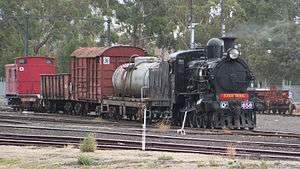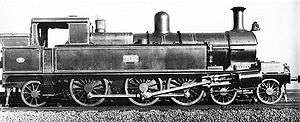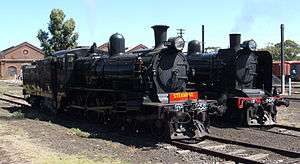Victorian Railways Dd class
|
VR photo of Dd 590 as built, 1902 | |||||||||||||||||||||||||||||||||||||
| |||||||||||||||||||||||||||||||||||||
| |||||||||||||||||||||||||||||||||||||
| |||||||||||||||||||||||||||||||||||||
| |||||||||||||||||||||||||||||||||||||
The Dd class (later reclassified into D1, D2 and D3 subclasses) was a passenger and mixed traffic steam locomotive that ran on Victorian Railways from 1902 to 1974. Originally introduced on mainline express passenger services, they were quickly superseded by the much larger A2 class and were relegated to secondary and branch line passenger and goods service, where they gave excellent service for the next fifty years. The Dd design was adapted into a 4-6-2T tank locomotive for suburban passenger use, the Dde (later D4) class. They were the most numerous locomotive class on the VR, with a total of 261 Dd and 58 Dde locomotives built.
History
By 1900, Victoria's express passenger locomotive fleet was almost exclusively made up of 4-4-0 designs of the Old A, New A, and the most recent AA class. These locomotives reflected contemporary British locomotive practice (as did the VR's fleet of 0-6-0 goods locomotives), in no small part due to the Victorian Government having appointed, in 1884, a Midland Railway manager, Richard Speight, as its first Chief Railways Commissioner. The Commissioners then asked British locomotive engineer Edward Jeffreys to design five standard types of locos, in partnership with the British locomotive manufacturer (Kitson & Co. of Leeds).[1]
At the turn of the century, in what marked a major shift in policy, the VR under recently appointed Commissioner Mr. J Mathieson set up a Locomotive Design Section for in-house development of future motive power. The Dd class locomotives were the first product of this exercise.[2] A 4-6-0 design equipped with 5 ft 1 in driving wheels, saturated steam boiler and Belpaire firebox, the Dd reflected the considerable talent of VR's design team, which included ex-Beyer, Peacock and Company recruit Eugene Siepen, future VR Chief Mechanical Engineer Alfred Smith, and Rolling Stock Branch manager Thomas Woodroffe.[3]
Production
The Dd class is notable for being the last class of locomotive to be built by Ballarat's Phoenix Foundry, which had been the main supplier of locomotives to the VR for over thirty years, and the first locomotive class to be constructed in large numbers by VR's own newly built Newport Workshops. That was because the conservative Irvine government sought to reduce the costs of locomotive construction, and Newport Workshops was asked to tender for the construction of the Dd class locomotives. A fierce tender war between Newport and Phoenix eventually resulted in a Royal Commission, which found that Newport could produce a locomotive for £3,364, some £497 cheaper than the Phoenix Foundry.[3] Phoenix produced just seven Dd locomotives and received no further orders, going into voluntary liquidation a year later.[3] VR's Newport, Ballarat and Bendigo workshops went on to build virtually all subsequent locomotives for the Victorian railway system until the post-war era.
Regular service
Dd class locomotives were initially assigned to hauling the Adelaide Express over the steep gradients between Melbourne and Ballarat, but were soon seen on mainline passenger services on a number of lines.[4]
The first years of the 20th century saw on the VR (as elsewhere in the world) a considerable increase in both the amount of traffic and the size and weight of rolling stock being hauled. In 1907, the Dd class was supplanted by the much larger and more powerful Victorian Railways A2 class on principal mainline services.[5] However, with their light axle load (just 12 t 10 cwt in their original form),[6] they were quickly reassigned to the VR's branchline network, where they became a fixture for the next fifty years.[7]
With their light axle load and express passenger speed, the Dd was also an ideal choice as motive power for the Victorian Railways Commissioner's train (used to carry the VR Commissioners on inspection tours to every corner of the VR network). In 1916, locomotive Dd 980 (later rebuilt as D3 639) was assigned as the Commissioner's engine[8] and continued in this role for the next forty years.
Dde tank engine
|
Victorian Railways photograph of Dde 702, circa 1910 | |||||||||||||||||||||
| |||||||||||||||||||||
| |||||||||||||||||||||
| |||||||||||||||||||||
The expansion of Melbourne's population into new suburbs early in the 20th century and the delay of the suburban electrification project[9] saw the need for faster and more powerful steam locomotives for the suburban rail network. The basic design of the Dd was in 1908 adapted into a 4-6-2T tank locomotive, classed Dde. They were put to work on longer and hillier suburban routes such as the Dandenong, Frankston, Upper Ferntree Gully, Williamstown, Werribee, Lilydale, Darling and Kew railway lines. A total of 58 were built between 1908 and 1913.[10]
With electrification of the suburban network already on the drawing board (the first electrified lines opening in 1919), the Dde was designed for easy conversion to Dd tender engines in the event of electrification making them redundant. However, only two were modified in this way.[10] Ten were scrapped in 1924, followed by another four in 1925 and the sale of Dde 704 to the State Electricity Commission of Victoria.[11] The remaining Dde locomotives remained in service on non-electrified outer suburban routes or found new roles as suburban goods locomotives or shunters. Some were allotted to Ballarat to work the short branch line to Newlyn.
Design improvements
During the construction of the Dd class, a number of changes were made. The first locomotives built featured low running plates with splashers over the driving wheels and a narrow cab. However, after 26 such examples were built the design was altered[10] with high running plates mounted above the driving wheels and a more comfortable full-width pressed metal cab of Canadian design, a feature incorporated at the request of Victorian Railways Chief Commissioner and former Canadian Pacific Railway Transportation Manager Thomas Tait.[4] These became hallmarks of all subsequent VR steam locomotive designs.
Although the Dd was considered to be a successful design, it had a key shortcoming in that its boiler performance was not sufficient for the traffic demands being placed on it. In 1914, an experimental superheater was fitted to Dd 882 and was found to be very successful.[10] Both Dd and A2 designs (both locomotive classes still under construction at the time) were modified with superheated boilers (with all of the existing A2 class locomotives eventually fitted with superheated boilers). Superheaters were also fitted to three of the Dde locomotives.[10] Further Dd locomotives were also built with 19 in. diameter cylinders in place of the original 18 in. cylinders.[10]
In 1923-4, DD.1022 was experimentally fitted with Pulverised Brown Coal (PBC) burning equipment.[12]
Reclassing: D1, D2 and D4 class
In 1922 a complex renumbering and reclassing of VR locomotives saw the Dd class split into two subclasses, the D1 class (comprising all the original saturated steam locomotives with 18 in. cylinders) and the D2 class (comprising superheated locomotives with either 18 or 19 in. cylinders).
With the introduction of a further D3 class in 1929, the Dde tank locomotives were reclassified as D4 class in 1929.
The D3 class
|
Preserved D3 locomotive (left) adjacent to a K class locomotive, the boiler design of which formed the basis for the D3 boiler. | |||||||||||||||||||||
| |||||||||||||||||||||
| |||||||||||||||||||||
| |||||||||||||||||||||
Despite the success of the superheating the Dd boiler, it was still somewhat limited in steam raising capabilities. In 1922, a new design of 2-8-0 branch line goods locomotive, the K class was introduced, with noticeably superior boiler performance to that of the Dd. In 1929, a Dd class locomotive was rebuilt with a larger boiler derived from the K class design. Based on the success of the rebuild, a further 93 D1 or D2 class locomotives were converted between 1929 and 1947.
The D3s were economical and efficient, but also renowned for their superior performance. They could be worked hard and were a favourite with crews.[8] Although restricted to a maximum permitted speed of 60 mph (96 km/h), the D3s were known to be capable of up to 75 mph (120 km/h).[4]
With their ability to travel at relatively high speed and their low axle load, the D3 helped to speed up passenger services on many lightly laid branch lines.
Demise
Scrapping of Dd class locomotives commenced as early as 1929, with newer K and N class locomotives taking over branch line goods services and Petrol Electric Rail Motors (and later Diesel Electric Rail Motors) starting to replace mixed trains and locomotive-hauled branch line passenger services.[13][14] The unrebuilt saturated steam D1 class locomotives were the first to go, and by 1951 no fewer than 120 had been scrapped.[4]
By 1951, the remaining D1 locomotives were shunters, the D2 locomotives providing suburban goods and branch line goods and passenger service, and the D3 performing both branch line and mainline service. However, with the massive postwar upgrading of the VR locomotive fleet as part of 'Operation Phoenix' came the introduction of J class 2-8-0 branch line steam locomotives[7] and T class (EMD G8) diesel electric locomotives to replace the various remaining Dd locomotives.[15]
The first D3 locomotive to be scrapped was none other than Commissioner's locomotive D3 639 in November 1958. However, this locomotive had attained sufficient prestige that its brass fittings and number plates were transferred to another locomotive, D3 658, which took over its role as Commissioner's locomotive and its identity as "D3 639".[4]
Withdrawals and scrappings continued throughout the 1950s and 60s. The last Dd in VR service was the Commissioner's locomotive D3 639, which was replaced in this role by a Y class (EMD G6B) diesel electric locomotive specially regeared for 60 mph (97 km/h) operation (Y 175) in 1968.[16] However, D3 639 had since October 1964 taken on a new role providing motive power for the ARHS 'Vintage Train' as the first 'Special Trains Vintage Engine',[17] and continued in this popular role until deteriorated boiler condition saw it finally withdrawn from service in 1974.
Preservation

Operational
D3 639 was restored to operating condition in 1984 and was recommissioned into service by the Prime Minister of Australia Bob Hawke on 17 November 1984.[17] Since this date, it has continued in service hauling various rail enthusiast special trains. It has also been used in a number of films, and could be seen hauling passenger trains beneath an inoperable overhead catenary in the 2000 remake of the post-apocalyptic film On the Beach. ,[18] A rebuild of a 1903 Dd locomotive, it made a special long-distance journey to Mildura, Victoria in 2002 as that line approached its centenary, and celebrated its own 100th anniversary in 2003 with a journey to Swan Hill.[19] As of 2007, it has reverted to its earlier D3 658 numbering. As of 2009 the loco has again reverted to the 639 number.
Static
A single example of each of the D2 and D4 locomotives were retained for preservation. D2 604 and D4 268 are today on display at the Australian Railway Historical Society North Williamstown Railway Museum, as well as a further example of the D3 class, D3 635.
13 other D3 class locomotives remain, either preserved in static display or stored awaiting restoration or as a supply of parts.
No original D1 class locomotives have survived into preservation.
References

- Dee; et al. (1981). Power Parade. Melbourne: VicRail Public Relations Division. ISBN 0-7241-3323-2.
Specific
- ↑ "Power Parade: Colonial Steam Power". Victorian Railways. Museum Victoria. Retrieved 16 September 2014.
- ↑ "Victorian Railways, Museum Victoria, Australia: Setting New Standards". Museum Victoria. Retrieved 7 April 2007.
- 1 2 3 Lee, Robert (2007). The Railways of Victoria 1854-2004. Melbourne University Publishing Ltd. p. 165. ISBN 978-0-522-85134-2.
- 1 2 3 4 5 Oberg, Leon (1996). Locomotives of Australia 1850's - 1990's. NSW: Kangaroo Press. p. 230. ISBN 0-86417-779-8.
- ↑ "Victorian Goldfields Railway Steam Locomotives". Victorian Goldfields Railway. Retrieved 7 April 2007.
- ↑ "BUILDERS DRAWING DD CLASS STEAM LOCOMOTIVE AND TENDER (VPRS 12903/P1 Box 599/05)". Public Record Office Victoria. Retrieved 6 April 2007.
- 1 2 "The New J Class". The Victorian Railways Newsletter: 4–5. May 1954. Retrieved 31 December 2006.
- 1 2 "D3class:VR:Trains:AJH". Retrieved 7 April 2007.
- ↑ "Dd Class Locos". Victorian Railways, Museum Victoria, Australia. Museum Victoria. Retrieved 7 April 2007.
- 1 2 3 4 5 6 Pearce (1980). North Williamstown Railway Museum. Melbourne: ARHS. p. 10. ISBN 0-85849-018-8.
- ↑ Oberg, Leon (1984). Locomotives of Australia 1850's - 1980's. NSW: Reed Books. pp. 102–103. ISBN 0-7301-0005-7.
- ↑ Buckland, John L. (July 1972). "Pulverised Brown Coal Fuel for Steam Locomotives". Australian Railway Historical Society Bulletin: 145–161.
- ↑ "ARHS Railway Museum: History 1900 - 1950". Retrieved 7 April 2007.
1948/51 - In response to the desire to reduce the number of un-economical mixed train services on lines where there was light traffic, to improve the standard of service provided, and in response to the uncertainties of coal supplies in the post war period; a significant number of additional railcars were purchased from Walkers of Wigan, England.
- ↑ "The Pride of the Diesel Fleet". The Victorian Railways Newsletter: 4. July 1950. Retrieved 7 April 2007.
- ↑ "And now the T's". The Victorian Railways Newsletter: 3. October 1954. Retrieved 2007-01-01.
- ↑ "V/Line: Y Class". Retrieved 7 April 2007.
- 1 2 "Steamrail Forum ~ View topic - D3 class Steam Locomotives". Steamrail Victoria. Retrieved 8 April 2007.
- ↑ Russell Mulcahy (Director) (2000). On the Beach (TV). Australia.
- ↑ "VICSIG - Locomotives - D3 639". Retrieved 9 April 2007.


